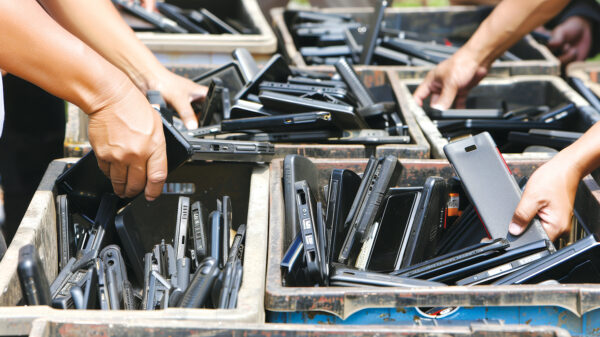by MAURA KELLER
Faced with high energy costs, environmental concerns by consumers, and government regulatory measures, the world’s leading automakers are embracing electric vehicle (EV) technology like never before.

In fact, in early 2021 General Motors pledged to stop making gasoline-powered vehicles by 2035 and will be embracing a future of all EVs, all the time. So what does this mean for the automotive recycling industry in terms of the handling of lithium ion batteries (LIBs) and other components in these vehicles? While electric vehicles are a feat of technology wizardry, when their lives come to an end, or at least their batteries die, the cells of LIBs can release toxic elements into the environment. That’s why there’s a significant focus on the recyclability and renewability of LIBs in the automotive recycling arena.
Gavin Harper, a Faraday Institution Research Fellow, and lead author of “Recycling Lithium Ion Batteries for Electric Vehicles,” said the automotive recycling industry will need to change and adapt in order to deal with electric vehicles. Firstly, lithium ion batteries (LIBs) must be removed before vehicles are shredded. Given the size and weight of these battery packs, this will require equipment for manual handling.
“Operatives will need to be trained to deal with disconnecting the high voltage interconnects safely with insulated tools. There will also need to be the development of procedures for safely handling and shipping batteries onwards for remanufacture, reuse or recycling,” Harper said. “There are also some risks associated with crash-damaged batteries. Given the additional labor this adds to vehicle recycling, in the long-run, this operation will become automated in order to speed the recycling of vehicles and remove employees from risky operations.”
Also, Harper stressed that attention should also be given to electric motors. As he explained, at the moment, if you put an EV motor with a permanent magnet through an auto shredder, you will end up with fine magnet dust that sticks to auto shredders causing premature aging, as it acts as a fine abrasive.
“It also renders the magnetic material unsuitable for onwards recycling or further use,” Harper said. “Motors should also be removed for remanufacture, reuse or recycling prior to shredding the vehicle.”
Also, as the EV revolution progresses, manufacturers may change to using different body structures in their vehicles. For example, the BMW i series use more carbon fiber in the body and these present unique recycling challenges.
Eric Schwartz, president of Autocar Industries, LLC in Hagerstown, Indiana, said he sees two key issues plaguing the electrification of today’s vehicles: the scarcity of materials needed for the batteries and how to effectively recycle them.
As such, Schwartz said the automotive industry needs to find a way to reduce the number of metals needed for EV batteries.
“While there is not currently a shortage in lithium or nickel, scaling to the predicted amount needed might be difficult,” Schwartz said.
“Cobalt is the bigger concern with two-third of the global supply coming from the Democratic Republic of Congo. Finding effective and environmentally friendly ways to recycle these metal components from the lithium-ion batteries will become even more important than ever. However, because the lifespan of lithium-ion batteries is about 20 plus years, we still have time but the issue needs to remain a priority.”
In May, Autocar announced an emissions-free, all-electric version of its terminal tractor, the Autocar E-ACTT. Autocar is the only terminal tractor original equipment manufacturer with a single OEM-developed and produced electric vehicle system. The E-ACTT makes a great work truck even better by helping meet regulatory mandates for the vocational truck industry in reducing fuel consumption by 24 percent by the model year 2027 and in California, to transition diesel trucks to zero emission trucks.
Schwartz added that one of the biggest challenges with EV batteries is that they are not designed to be recycled and they vary in design based on the manufacturer. “Additionally, they are often built for toughness and are difficult to dismantle,” Schwartz said. “However, researchers are examining ways to repurpose EV batteries, after their life powering a vehicle, for less-demanding tasks like storing electricity from solar panels and wind turbines.”
In addition, Ian Gardner, chief executive officer, GoFor Delivers, a company that offers renewable delivery services via EVs that help companies cut costs and go carbon negative, also pointed out that both the automotive industry as well as the recycling arm of the industry need to solve for the LIB issues since, by one estimate, upward of 12 million tons of lithium-ion batteries will reach end of life by 2030.
“All other components of EVs are easier to recycle than they are in an internal combustion engine vehicle,” Gardner said. “For example, there are fewer fluids – no engine oil, for example – which makes EVs more environmentally friendly. Also, the recent trend in using sustainable recycled materials in new vehicles helps a lot.”
As for the battery, Gardner predicted it will have a long usable life. After its mobile use, it can be used for stationary purposes. It’s estimated that EV batteries might last up to 30 years.
“Recent technology even lets us stop and reverse the decay in battery cells. Also, the lithium and cobalt in battery cells can be extracted and reused,” Gardner said. “While the process is costly, it’s worthwhile because the cost and carbon footprint of mining these materials are also large.”
Being In the Know
Auto recyclers need to be aware of the dangers associated with high voltage electricity and have appropriate training within the domain of EV battery recycling. Disassembly of battery packs from automotive applications requires high-voltage training and insulated tools to prevent electrocution of operators or short-circuiting of the pack.
Furthermore, Harper said there needs to be safe handling procedures around crash-damaged batteries, which present a number of risks in terms of both fire and thermal events, but also the potential for toxic off-gassing.
“Auto recyclers need to know how to store EV batteries safely once they have been removed, and if there is any chance of auto-ignition, the batteries should be stored away from other flammable items,” Harper said. Given that stockpiling of waste batteries is potentially unsafe and environmentally undesirable, if direct re-use of an LIB is not possible, it must be repaired or recycled.
A Future Outlook
The automotive recycling industry will undergo massive transformation and reconfiguration in its operations in the coming years as the focus changes to EVs. But the level of impact EVs will have on auto recyclers depends how much value auto recyclers want to capture from these vehicles.
“Do they want to focus on selling the battery onwards to other firms who can provide the specialized gateway testing, remanufacture, reuse and recycling of lithium ion batteries, or do firms want to engage more with triaging batteries that have been removed from vehicles, so they can be sold into the highest value application?” Harper said. “Also, if more manufacturers change the makeup of electric vehicles in order to be lightweight, this will affect the recycling of body structures significantly. We strongly believe that there will be more concentration and more automation in the end-of-life treatment of vehicles.”
To help develop a globally competitive EV recycling industry, the U.S. Department of Energy launched a lithium-ion battery recycling center, the ReCell Center. As Schwartz explained, collaborators from across the battery supply chain – from battery manufacturers to automotive original equipment manufacturers (OEMs) and recycling – are working with the ReCell Center.
“One of its goals is to design batteries with recycling in mind and create future batteries that are easier to recycle,” Schwartz said. “For example, several battery manufacturers are already looking for substitute chemistries for lithium and cobalt, such as sodium. We are watching this developing science with great interest.”
Looking ahead, Gardner said recycling EVs will be a great business and ecologically very important. “Technology will dominate here, and there will be a lot of innovation in the market,” Gardner said. “The bigger challenge is getting rid of all these diesel and gas vehicles, with their polluting oils and residual materials, poisonous catalytic converters and tar-stuffed exhaust pipes.”
Published in the November 2021 Edition







